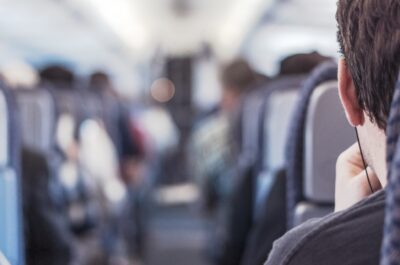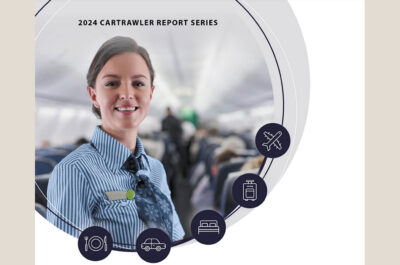The ancillary revenue revolution is spreading its ideas and impacting on air travel and its companion industries such as accommodation, cruising, car rental, credit cards, dining and more.
DUBLIN, IRELAND: The business upheaval that began in the air travel industry a decade ago, has now grown to span the globe and has brought economic vitality back to the world’s airlines, enabled the worldwide boom in low-cost travel and granted consumers the gift of choice. The ancillary revenue revolution is spreading its ideas and impacting on air travel and its companion industries such as accommodation, cruising, car rental, credit cards, dining and more.
|
Worldwide Estimate of Ancillary Revenue |
|
|||
|
2013 Estimate $42.6 billion (6% of Global Airline Revenue of $708 billion) |
2012 Estimate $36.1 billion (5.4% of Global Airline Revenue of $667 billion) |
2011 Estimate $32.5 billion (5.6% of Global Airline Revenue of $577 billion) |
2010 Estimate $22.6 billion (4.8% of Global Airline Revenue of $474 billion) |
|
|
Source: Ancillary revenue statistics applied by IdeaWorksCompany to individual airline revenue results for the year indicated from Air Transport World, Airline Business, and at airline websites. |
||||
‘Top 10 Things You Need to Know about Ancillary Revenue’, the newest report from CarTrawler and the IdeaWorksCompany, describes the depth and breadth of this phenomenon, which has transformed the world’s largest industry. More than 1 billion people traveled internationally in 2013, according to UN statistics, and the vast majority of them have experienced the ancillary revenue revolution in one way or another. The new report identifies many key elements of this phenomenon, including:
- The king of a la carte fees remains baggage charges, which totaled $3.5 billion in the United States in 2012. Bag fees are now spreading across the world, to Europe and beyond.
- Service-specific fees, such as bag charges, inherently yield better results for consumers by turning a once-free item into a stand-alone business. Mishandled bags, for instance, once the bane of frequent travelers, have declined more than 50 percent worldwide since 2007.
- High-value customers, the key demographic sought by service industries, are happy to utilize ancillary services such as premium travel (early boarding and extra legroom). 11 airlines now offer VIP airport services that may include luxury sedan rides to the plane.
- Transparency is key to success. Not only do government regulators worldwide require disclosure and clarity with ancillary fees, the best companies realize that no amount of extra revenue can make up for the damage represented by angry consumers—a fact Ryanair is learning as it moderates its “crawl over broken glass” customer-service philosophy.
- Frequent-flier programs bring in billions in extra revenue through co-branded credit cards, and also provide a welcome marketing platform for other services, such as car rental and lodging.
|
CarTrawler Worldwide Estimate of Ancillary Revenue – by Carrier Type for 2013 |
|||
|
Airline Category |
Total Ancillary Revenue |
Frequent Flier & Commission Based |
A la Carte Fees |
|
Traditional Airlines |
$14.6 billion |
$8.8 billion |
$5.8 billion |
|
US Major Airlines |
$14.3 billion |
$9.3 billion |
$5.0 billion |
|
Ancillary Revenue Champs |
$7.5 billion |
$0.4 billion |
$7.1 billion |
|
Low Cost Carriers |
$6.2 billion |
$0.4 billion |
$5.8 billion |
|
Worldwide Totals |
$42.6 billion |
$18.9 billion |
$23.7 billon |
|
Source: Ancillary revenue statistics applied by IdeaWorksCompany to individual airline revenue results for the year indicated from Air Transport World, Airline Business, and at airline websites. |
|||
Analysis performed by IdeaWorksCompany during the past four years reveals natural groupings (or categories) based upon a carrier’s ability to generate ancillary revenue. The “percentage of revenue” results associated with four defined categories have been applied to a worldwide list of operating revenue disclosed by 176 airlines. The following describes the four categories:
- Traditional Airlines. This category represents a catch-all for the largest number of carriers. Ancillary revenue activity may consist of fees associated with excess or heavy bags and limited partner activity for a frequent flier program. Some are adding fees for the first checked bag. The average percentage of revenue increased to 3.1% from 2.9% last year. Examples include Gulf Air, Hainan Airlines, TAP Portugal, and Singapore Airlines.
- Major US Airlines. US-based majors generate strong ancillary revenue through a combination of frequent flier revenue and baggage fees. The percentage of revenue for this group was 9.9%, which dropped slightly from the 2012 rate of 10.1%. Examples include Alaska, American, and US Airways.
- Ancillary Revenue Champs. These carriers generate the highest activity as a percentage of operating revenue. The percentage of revenue achieved by this group grew to 21.6% from 19.7% for 2011. Examples include Air Arabia, Jetstar, Germanwings, and Spirit.
- Low Cost Carriers. LCCs throughout the world typically rely upon a mix of a la carte fees to generate good levels of ancillary revenue. The percentage of revenue for this group was 10.5% and is appreciably above last year’s 7.2%. Examples include flydubai, Spicejet, Transavia, and WestJet.
The US Major Airlines category produces a significant share of global ancillary revenue. The $14.3 billion result (33.7% of the global total) is generated by just seven airlines: Alaska Airlines, American, Delta, Hawaiian, Southwest, United, and US Airways. Southwest was redefined this year from being a low cost carrier to the US major category because the frequent flier revenue portion of its ancillary revenue profile has significantly increased; nearly 60% of ancillary revenue is estimated to be produced by its Rapid Rewards program.
IdeaWorksCompany believes the majority of ancillary revenue for US major airlines is generated by the sale of frequent flier miles, mostly those linked to co-branded credit cards. Baggage fees for US carriers represent approximately 25% of their ancillary receipts. The remaining revenue is produced by an array of a la carte and commission-based products. The profile for Southwest is certainly different because it does not charge for the first or second checked bag.
Other sources include onboard sales of food, beverages, Wifi, and commissions from hotel bookings. In addition, airlines offer an ever-increasing selection of services that add to traveler convenience such as priority security screening, early boarding, exit row seat assignments, single visit access to airport lounges, and VIP-style services at the airport.
The Traditional Airline Category (for carriers outside the US) is the largest piece of the pie at $14.6 billion (34.2% of the global total). The revenue profile for these carriers (see Graph 3) also relies upon the sale of frequent flier miles to partners such as the banks that issue airline credit cards Baggage revenue for these carriers is quickly increasing because more are introducing charges for the first bag. For example, Air France, British Airways, KLM, and Swiss introduced bag charges for intra-Europe flights during the first half of 2013.
The Low Cost Carriers and Ancillary Revenue Champs categories feature a diverse array of revenue from optional services and commission-based products. These carriers have the lowest level of revenue produced by frequent flier program activity. Their co-branded credit card portfolios are younger and far smaller; card revenue levels rarely match those associated with long-established airlines.
Approximately 40% of the $42.6 billion ancillary revenue increase for 2013 can be explained by a global airline industry that is producing better revenue results and carrying more passengers. The remaining 60% amount is being delivered by more effective and aggressive ancillary revenue efforts by Ancillary Revenue Champs, Low Cost Carriers, and Traditional Airlines. Revenue-savvy carriers are testing variable pricing for more services that adjust fees according to demand. Pricing methods, such as the branded fares approach, encourage consumers to pay a premium price for a package of defined amenities. Traditional airlines are rapidly learning the value of ancillary revenue by implementing fees for the first checked bag and relying on distribution enhancements that allow travel agents to book optional extras for corporate and leisure clients.
|
CarTrawler Worldwide Estimate of Ancillary Revenue – by World Region for 2013 |
|||
|
Airline Category |
Total Ancillary Revenue |
Frequent Flier & Commission Based |
a la Carte Fees |
|
North America |
$17.2 billion |
$9.7 billion |
$7.5 billion |
|
Europe |
$12.6 billion |
$3.4 billion |
$9.2 billion |
|
Asia/Pacific |
$9.1 billion |
$3.9 billion |
$5.2 billion |
|
Africa/Middle East |
$2.3 billion |
$1.2 billion |
$1.1 billion |
|
Latin America/Caribbean |
$1.4 billion |
$0.5 billion |
$0.9 billion |
|
Worldwide Totals |
$42.6 billion |
$18.7 billion |
$23.9 billion |
|
Source: Ancillary revenue statistics applied by IdeaWorksCompany to individual airline revenue results for the year indicated from Air Transport World, Airline Business, and at airline websites. |
|||
“A la carte activities, such as those linked to fees charged for checked bags, onboard cafes, and early boarding privileges, are a big part of the ancillary revenue story,” says Jay Sorensen, President, IdeaWorksCompany. “Globally, about 56% of ancillary revenue is produced by the optional extras sold to consumers at airline websites, onboard aircraft, and increasingly through travel agents and online travel retailers. This leaves a significant 44% share provided by business opportunities linked to a passenger’s trip such as hotel and car rental bookings, and even the use of a co-branded credit card to accrue frequent flier miles or points.”
The world’s airline industry is enjoying better financial results and a rare glimpse of profitability. The boost provided by ancillary revenue can help ensure these results are firm and not fleeting. The International Air Transport Association (IATA) projects $708 billion in global airline revenue ($227 per passenger) and $11.7 billion in total net profits for 2013. The numbers have a robust ring, but in reality this only represents a 1.6% net profit margin.
Tony Tyler, Director General of IATA, framed these figures in reality when he observed the results deliver a modest profit of about $4 per passenger… which is “less than the price of a sandwich in most parts of the world.” IATA projects 3.12 billion passengers globally for 2013, which, using the IdeaWorksCompany estimate, yields an ancillary revenue result of $13.64 per passenger, or $7.64 from a la carte fees. At a level considerably above $4, ancillary revenue has become a necessary ingredient in the industry’s fiscal health − 6 percent of total revenue − and is becoming a method for consumers to pick and choose the service and price that are just right for them.
Vicky is the co-founder of TravelDailyNews Media Network where she is the Editor-in Chief. She is also responsible for the daily operation and the financial policy. She holds a Bachelor's degree in Tourism Business Administration from the Technical University of Athens and a Master in Business Administration (MBA) from the University of Wales.
She has many years of both academic and industrial experience within the travel industry. She has written/edited numerous articles in various tourism magazines.






























































































































































































